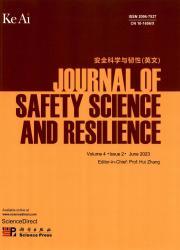Optimizing firefighting resilience in airports through genetic algorithms and decision-making frameworks
IF 3.4
Q1 PUBLIC, ENVIRONMENTAL & OCCUPATIONAL HEALTH
引用次数: 0
Abstract
Aviation transport infrastructure is key to international commerce and cultural exchange, with any emergency potentially causing major impacts on contemporary society. With advancements in technology and growing societal needs, modern airports are evolving toward smarter and more integrated systems. While transportation engineers and planners aim to bolster resilience in subsystems and transport management with new technologies and diverse strategies for effective risk management, the growing complexity of disaster-inducing factors and fire dynamics in airport systems somewhat diminishes the accuracy of existing risk vulnerability analyses. It drives the demand for enhanced firefighting resilience. This study discusses assessment and improvement strategies for enhancing the resilience of airport firefighting systems in the context of smart airports. Specifically, we analyze the resilience characteristics of airport firefighting systems, which can be subdivided into four dimensions: stability capability, resistance capability, recovery capability, and adaptability capability. Furthermore, by integrating human, mechanical, environmental, and managerial elements, a comprehensive resilience evaluation indicator system is constructed. We propose a modified composite weight calculation framework that innovatively introduces genetic algorithm (GA) in the weight combination process to simplify the model into a constrained minimization problem from a mathematical perspective, thus making the ranking results reflect ordinal and intensity information. The findings highlight the significance of technological advancements, emergency response capabilities, expertise in fire management, cross-departmental collaborative responses, personnel psychological quality, and accident investigation skills in enhancing the resilience of airport firefighting systems. Although the comprehensive evaluation model based on expert knowledge still focuses primarily on resistance, the criterion of adaptation capability has a more pronounced increasing trend in weight under correction, highlighting its significant role and potential in future airport firefighting resilience indicators. This research aims to offer guidance to the aviation sector and managers for devising appropriate protection strategies, thereby improving public safety at airports.
通过遗传算法和决策框架优化机场的消防弹性
航空运输基础设施是国际商业和文化交流的关键,任何紧急情况都可能对当代社会造成重大影响。随着技术的进步和社会需求的增长,现代机场正朝着更智能、更集成的系统方向发展。虽然交通工程师和规划师希望通过新技术和多样化策略来提高子系统和运输管理的复原力,从而实现有效的风险管理,但机场系统中日益复杂的灾害诱发因素和火灾动态在一定程度上降低了现有风险脆弱性分析的准确性。这促使人们要求加强消防应变能力。本研究讨论了在智慧机场背景下增强机场消防系统抗灾能力的评估和改进策略。具体来说,我们分析了机场消防系统的弹性特征,可细分为四个维度:稳定性能力、抵抗能力、恢复能力和适应能力。此外,通过整合人力、机械、环境和管理等要素,构建了一个综合的弹性评价指标体系。我们提出了一个改进的综合权重计算框架,在权重组合过程中创新性地引入了遗传算法(GA),从数学角度将模型简化为一个受约束的最小化问题,从而使排序结果反映了顺序和强度信息。研究结果凸显了技术进步、应急响应能力、消防管理专业知识、跨部门协作响应、人员心理素质和事故调查技能对提高机场消防系统应变能力的重要意义。虽然基于专家知识的综合评价模型仍以抗灾能力为主,但适应能力标准在修正后的权重有较为明显的上升趋势,凸显了其在未来机场消防抗灾能力指标中的重要作用和潜力。这项研究旨在为航空部门和管理人员制定适当的保护策略提供指导,从而提高机场的公共安全。
本文章由计算机程序翻译,如有差异,请以英文原文为准。
求助全文
约1分钟内获得全文
求助全文
来源期刊

安全科学与韧性(英文)
Management Science and Operations Research, Safety, Risk, Reliability and Quality, Safety Research
CiteScore
8.70
自引率
0.00%
发文量
0
审稿时长
72 days
 求助内容:
求助内容: 应助结果提醒方式:
应助结果提醒方式:


